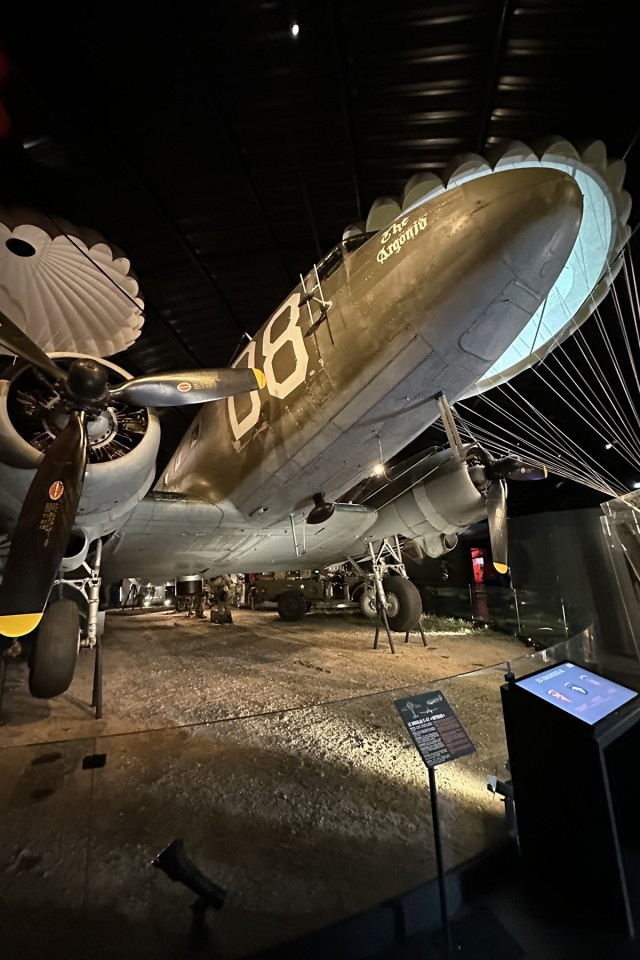On D-Day, June 6, 1944, as Allied forces stormed the beaches of Normandy, a different kind of invasion was unfolding inland. Among the thousands of paratroopers descending into occupied France was Army Private John Steele of the 82nd Airborne Division. Steele’s landing in Sainte-Mere-Eglise was far from ordinary; it was an event that etched his name into the annals of World War II history and popular culture.
The Perilous Descent into Sainte-Mere-Eglise
In the early hours of D-Day, amidst darkness and heavy cloud cover, C-47 aircraft carrying American paratroopers approached Sainte-Mere-Eglise. Their mission was critical: secure this strategically vital town near Utah Beach to prevent German reinforcements from pushing back the seaborne landings. Jumping from a mere 600 feet, the paratroopers had little time to react as they plummeted towards the ground. For John Steele, this descent took an unexpected and perilous turn.
 Army Pvt. John Steele poses for a photo in his dress uniform during World War II.
Army Pvt. John Steele poses for a photo in his dress uniform during World War II.
U.S. Army Private John Steele in dress uniform, a WWII paratrooper who became famous for his D-Day landing on the church steeple in Sainte-Mere-Eglise.
Steele’s parachute became entangled on the spire of the town’s church, leaving him dangling high above Sainte-Mere-Eglise. There he remained, suspended from the church tower for two long hours, a silent witness to the fierce fighting erupting below as his fellow paratroopers battled German forces. Eventually, Steele was captured by the Germans. However, his ordeal was far from over; he later managed to escape captivity and rejoin the fight.
From Sicily to Normandy: Steele’s Wartime Service
John Steele, born in Metropolis, Illinois, was older than many of his fellow soldiers when he enlisted in the Army shortly after Pearl Harbor in 1941 at the age of 29. Prior to his legendary jump into Normandy, Steele had already seen combat. In 1943, he participated in airborne operations in Sicily and Naples, Italy, gaining valuable combat experience that would serve him well in the battles to come.
 Paratroopers from the Army
Paratroopers from the Army
82nd Airborne Division paratroopers engaging German forces in Sainte-Mere-Eglise, Normandy, on June 7, 1944, during the D-Day operations.
Following D-Day and his harrowing experience in Sainte-Mere-Eglise, Steele continued to serve with distinction. He fought in Operation Market Garden in the Netherlands, a large-scale airborne operation, and was promoted to staff sergeant, demonstrating his leadership and resilience throughout the war. Steele survived the war, but tragically, his brother was killed in action in Germany just before the war’s end in Europe in April 1945.
The Legend Lives On: “The Longest Day” and Remembrance
John Steele’s remarkable story captured the public imagination, particularly after it was featured in Cornelius Ryan’s book “The Longest Day” (1959) and the subsequent 1962 film adaptation. In “The Longest Day,” actor Red Buttons, himself a WWII Army veteran, portrayed Steele. Steele attended the film’s premiere and reportedly praised Buttons’ portrayal, acknowledging the film’s impact in bringing the D-Day story to a wider audience.
 Army Pvt. John Steele, second from right, and three other soldiers pose for a photo during World War II.
Army Pvt. John Steele, second from right, and three other soldiers pose for a photo during World War II.
WWII photo of Army Private John Steele, second from right, with fellow soldiers, highlighting the camaraderie and service of paratroopers in World War II.
In 1964, John Steele returned to Sainte-Mere-Eglise for a regimental reunion. The town, forever grateful for the liberation brought by the American paratroopers, bestowed upon him the honor of honorary citizenship. Even after his death in 1969, Steele’s legacy continues to be remembered in Sainte-Mere-Eglise. A mannequin still hangs from the church steeple, a poignant reminder of the paratrooper who became an enduring symbol of D-Day and the sacrifices made during World War II.
 A mannequin depicts Army Pvt. John Steele whose parachute was entangled on a church steeple in the town of Sainte-Mere-Eglise in Normandy, France, when he landed on D-Day. This photo taken May 3, 2024.
A mannequin depicts Army Pvt. John Steele whose parachute was entangled on a church steeple in the town of Sainte-Mere-Eglise in Normandy, France, when he landed on D-Day. This photo taken May 3, 2024.
A mannequin representing John Steele hanging from the church steeple in Sainte-Mere-Eglise, France, commemorating his iconic D-Day experience as a paratrooper.
Beyond Steele: Stories of Other D-Day Paratroopers
While John Steele’s story is perhaps the most famous, other paratroopers who landed in Sainte-Mere-Eglise also experienced extraordinary events. Private Ken Russell, for instance, landed on the same church roof as Steele but did not achieve the same level of notoriety. He too, however, played his part in the liberation and survived the war.
 German soldiers pose for a photo in front of the Hotel de Ville in the town of Sainte-Mere-Eglise in Normandy, France, sometime before June 6, 1944, when U.S. Soldiers liberated the town.
German soldiers pose for a photo in front of the Hotel de Ville in the town of Sainte-Mere-Eglise in Normandy, France, sometime before June 6, 1944, when U.S. Soldiers liberated the town.
Historical image of German soldiers in Sainte-Mere-Eglise before D-Day, contrasting with the later liberation by U.S. paratroopers like John Steele.
Private First Class Clifford A. Maughan had a unique encounter when he parachuted into the garden of a house occupied by a German soldier. Initially captured, Maughan quickly turned the tables when U.S. forces overwhelmed the town, leading to the German soldier surrendering to him. Maughan also survived the war and later participated in the invasion of the Netherlands. Today, a plaque in front of the house, now a restaurant, honors Maughan and his fellow soldiers.
 A C-47 is featured in the Airborne Museum in Sainte-Mere-Eglise in Normandy, France. It is the same aircraft that dropped paratroopers into the town on D-Day, June 6, 1944. Photo taken May 3, 2024.
A C-47 is featured in the Airborne Museum in Sainte-Mere-Eglise in Normandy, France. It is the same aircraft that dropped paratroopers into the town on D-Day, June 6, 1944. Photo taken May 3, 2024.
C-47 aircraft, similar to those used to drop paratroopers like John Steele on D-Day, preserved at the Airborne Museum in Sainte-Mere-Eglise.
Conclusion
John Steele’s name is inextricably linked with D-Day and Sainte-Mere-Eglise. His unforgettable landing on the church steeple, immortalized in film and memory, serves as a powerful reminder of the courage and sacrifice of the American paratroopers who played a crucial role in the liberation of France and the turning tide of World War II. The stories of Steele and his fellow paratroopers continue to resonate, ensuring that their bravery and contribution to history are never forgotten.

